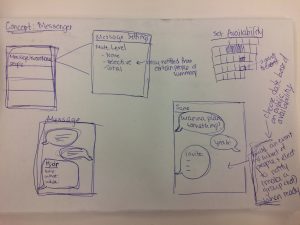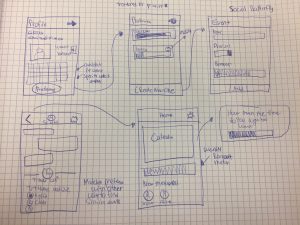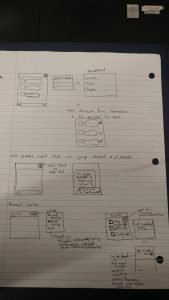Blog Update 2a:Next Steps*
The next steps of development will be to partake in generating low-fi and medium-fi prototypes while determining an appropriate experiment design to explore our conclusions further. Given limited time and resources, we will be focusing on two key learnings from our field study. Throughout interviews, all participants cited that familiarity plays an important role when factoring into their decision making process and levels of social exhaustion experienced. Given the role of familiarity there was an identified need to balance the types of events on priority, mutual friends attending and social exhaustion experienced. Additionally, users preferred face-to-face contact, so we should reflect that in limited time messaging online. While developing various machine learning components to recommend events or predict social exhaustion would be useful, this is beyond the scope of the course project.
Moving forward we plan to prototype strategies that could be used to address the high level learnings from our field study. We will explore different approaches of limiting conversation time to prompt action on the users part to schedule an event by suggesting an option that aligns with both users preferences. Given the need to categorize events, exploring ways to measure exhaustion and an event’s priority will be crucial. For example, when scheduling an event, it is important to know how challenging it is going to be so the user can make an informed decision. If they are unfamiliar with the event type, they may be more reluctant to go.
By exploring ways to categorize events, measure social exhaustion and prompt users to schedule, all while consolidating their messages and calendar we hope to address help introverts manage their social interactions more effectively.
*(300 word limit)
Blog Update 2b: Task Examples
Summary of Revisions:
- The provided task example for Erika captured most of the key insights of the data: mutual friends, social burnout that extroverts don’t have, the introvert trying to meet face to face.
- To make Erika’s example more meaningful we added a “group chat” component to capture the difference in comfort levels when interacting in such chats.
- For Alexa we modified movie to a non-interactive, familiar outing, this is capture the reliance of introverts on shared experiences such as mutual hobbies.
Alexa – The introverted college student
Alexa is an introverted college student. She finds it difficult to maintain her social relationships, especially when she gets busy, but it is important to her to keep her friends in her life and not let them feel abandoned. She wants to see her friends, because she takes joy in them, but finds it exhausting to reach out and make time, or to have many social events in close proximity. Alexa realizes she has not made plans with friends for over a month, and misses them. Though she normally waits until her friends reach out to her first, she reaches out to her friend Laura, and asks how she is. Alexa says they should do something soon. When Laura suggests a day, Alexa writes the date and time down on her calendar so she can plan around it. When the day arrives, Alexa feels burned out and asks if they can do it another week instead. Alexa writes a post-it note reminder to reschedule with Laura. The next week, after seeing the post-it note every day and feeling guilty, Alexa reaches out to Laura again, and suggests they meetup make Origami and watch movies. Alexa enjoys the common ground and it isn’t a lot of pressure. They make plans for Friday night. Alexa stays in Monday through Thursday so she won’t be tired. When Friday arrives, Alexa brings her Origami paper and goes to Laura’s to watch movies. After one movie, Alexa is tired and goes home.
Taylor – Social burnout with strangers
Taylor goes out with his friend Jason’s friends on Tuesday. While Jason’s friends are very welcoming, Taylor is uncomfortable around strangers and begins to feel very exhausted after an hour. Taylor makes an early exit after 2 hours. He tells Jason he is leaving, and Jason is hurt that he is leaving so early. Taylor has plans with his and Jason’s mutual friends on Wednesday, but he is socially exhausted from Tuesday night. He messages Jason and tells him he is feeling burned out. Jason is annoyed and tells him he has to come. Taylor feels guilty, so forces himself to go out. However, he doesn’t have fun and leaves after an hour. The next day, Taylor messages Jason and tells him he is sorry, and explains that he is burned out from meeting so many new people. He tells Jason that in the future he will leave more time around events that are tiring to him. Jason understands and promises to try not to overburden him. Taylor appreciates his friend understanding.
Erika – The extrovert who just wants to hangout
Erika wants to go out to karaoke on a Wednesday. She starts a group chat with 15 of her friends, inviting them to go out. Erika receives numerous responses within the next few hours. 4 of her friends cite tiredness and decline. 2 of her friends express possible (non-committal) interest. The remaining 4 express definite interest. The remaining 5 do not respond. Erika stays in contact with the 4 definites to finalize a plan. Erika drives the plan, suggesting an exact time to meet and get a table that they should all arrive. Erika promises to keep the 2 maybes posted. Erika arrives at karaoke on time. 2 of the definite friends arrive shortly after. Erika lets the maybes know that they are there in case they want to join. Only one responds, and says they might be able to go later. One more of the definites arrives. After several hours, most of the group is tired and wants to leave. Erika doesn’t want to go yet, so messages several friends to see what else is going on. She goes and meets some other friends at a bar for drinks until late, and then goes home.
Blog Update 2c: Prioritized List of Requirements
Requirements: Absolutely Must Include
These requirements represent the most common themes (event familiarity, event exhaustion level, and focus on face-to-face participation) among participants. These are the biggest problems to solve in addressing introverts’ socializing problems (particularly when communicating with extroverts). Additionally, getting these requests will require more user testing and refinement than some of our “could include” requests.
- Events are categorized according to familiarity level so users can make informed decisions of how the events will make them feel.
- System includes a way to for users categorize and classify the type of social burnout experienced so they do not become overloaded.
- System includes a method of mitigating group chat use, so that users can achieve face to face communication faster.
Requirements: Should Include
These requirements are also very prevalent among users, but were slightly less important than our “must include” requirements because they require less additional user testing (mutual friends and invitation filtering).
- Mutual friends attending any event are very public.
- Users have the ability to specify how much social burnout is caused by an event.
- Users have the ability to specify filtering options for event invitations based on how appealing the invitation is (based on inviter).
Requirements: Could Include
This is less necessary because it was only mentioned by a couple participants, and it embodies a conflict about how users respond to event reminders, with some participants finding it helping, and others disliking the functionality.
- System includes a way to prioritize event reminders to users.
Requirements: Exclude
This is a great long term addition, but is currently out of scope and will not impair the core functionality.
- Machine learning algorithms to hone event discussions and invitations to user preferences.
Users: Must Include
The system must support all users who want to be involved in event planning in order to be relevant.
- Useable for anyone who wants to plan an event with their friends, regardless of WTC scale.
Users: Exclude
Since physically and mentally disabled users may have many other constraints on events and social activity, we are choosing not to support them at this time.
- Users with severe physical or mental disabilities.
Blog Update 2d: Design Alternatives
| Alternative #1: Unified Messaging Dashboard | |
| Description: User messages are collected all in one place and categorized/filtered depending on the members of the conversation. Option to “selectively mute” each message: so can filter by only receiving messages from certain people, or only receiving message summaries. Option to pre-suggest an event based on the availability of members (to get to face-to-face time faster), or have a “message summary” feature that prompts users to send a message that summarizes what has been discussed. Option to pre-invite people to group chat, then open the group chat with pre-defined idea, so all the planning is done ahead of time. Essentially blocked group chats until ready. | |
Strengths
|
Weaknesses
|
| Alternative #2: Weekly Planner | |
| Description: An interface that imports all the invitations to the events across all the social media platforms and stores them in a calender based on priority of the event. Priority is identified using different colors. Priority of an is set by considering factors such as number of friends attending the event, familiarity of the event. Option to prioritize events based on social burnout. Option to choose colors based on high and low priority. Option to set a reminder about the events. | |
Strengths
|
Weaknesses
|
| Alternative #3: Extensive Event Preferences | |
| Description: Regardless of the key interface (calendar or messages) this alternative explores having the user creating a curated list of common events maintained in app. Option to add the priority/preference level to the event, how socially exhausted it typically makes them feel and the type of event. These preferences could be used to provide suggestions to users who share similar preferences. A weekly “burnout” meter would be set by the user could be updated when new events are scheduled. | |
Strengths
|
Weaknesses
|
Sketches
Design [Alice]: Focus on a unified message dashboard where user can select to mute conversations, get a summary of the event and share said summary with a group of friends.
Design [Scott]: Focus on a curated list of events that the user is interested in with feedback to deal with the ‘burnout’ aspect of social interaction. A matching tool where users with similar event preferences is also proposed.
Design [Chavon]: Focus on group chat aspect that was the most used form of communication across both introverts and extroverts for event planning. Emphasis on rating mutual friends to determine how likely user would be to go to the event.
Design[Aayush]: Focus on a weekly calendar that lets user import all the event invitations and prioritize them based on factors such number of mutual friends attending the event and familiarity with the event.
Design [Anushka]: Focus on event based preferences and matching them to interests of the user. Relies on a lot of integration with user’s social media and texting and call logs to keep current modes of contact open to not be ‘just another social media app’.





